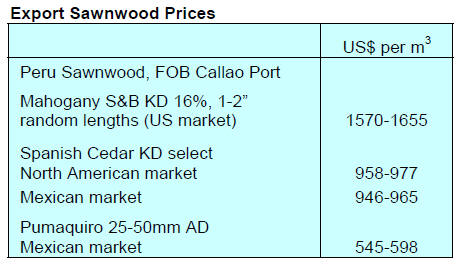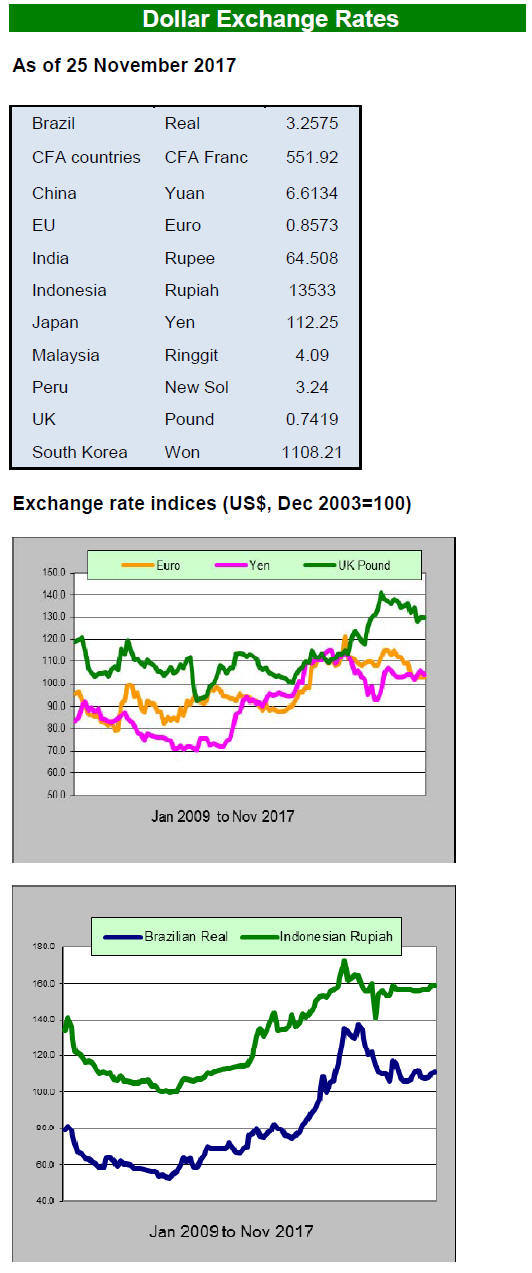2. GHANA
Investors promised litigation-free land for plantations
The Chief Executive Officer of the Ghana Forestry
Commission, Kwadwo Owusu Afriyie, has said the
Commission will release land for private plantation
developments across the country.
This initiative will contribute to efforts to restore Ghana’s
depleted forest cover and generate jobs and revenue for
government.
The plan is to expand public/private partnerships
which
deliver benefits for both government and the private
sector. The Forestry Commission promises potential
investors litigation-free land for medium and large scale
tree plantations.
The Commission’s CEO said the government wants to
attract investment from local corporations and businesses
but that he appreciates investing in forestry requires a long
term vision but still urges Ghanaians to take up the
challenge.
Sea port tariffs to go up in 2018
There are signs that the Ghana Ports and Harbours
Authority (GPHA) intends to revise tariffs in January 2018
which means exporters and importers will have to pay
more. The domestic press is reporting that charges could
go up anywhere between 5 – 20%. The current charges
were set 4 years ago.
To win understanding of the business community the
GPHA has engaged the Ghana Shippers Authority (GSA),
the Ship Owners, Agents Association, freight forwarders,
importers and exporters.
A rise in tariffs will increase the cost of doing business
and could significantly affect the costs of importing
machinery and spare parts as well as terminal handling
charges on exports.
The GPHA is a statutory corporation established to
provide efficient port facilities with the vision to make
Ghana a leading logistics hub for West Africa.
Government to improve conditions for expanded
industrialisation
The National Investment Bank (NIB) and the Ghana
Agriculture Development Bank (GADB) could be merged
into a new National Development Bank.
The rationale behind creating a new bank is to provide
competitive credit to the agricultural and manufacturing
sectors of the economy, thus aligning the banking
operations to the needs of the domestic industries rather
than, as is the case now, being focused on international
investments.
During the presentation of the 2018 budget the Finance
Minister, Mr. Ken Ofori-Atta, announced that the new
National Development Bank would have some US$500
million specifically for the agriculture and manufacturing
sectors.
Prof. Godfred Bokpin, Head of Finance at the University
of Ghana Business School, has applauded the proposal
while the Governor of the Bank of Ghana said it makes
sense for the NIB and the GADB to be merged. The
government of Ghana is determined to improve the
conditions for expanded industrialisation. The National
Development Bank could be launched before the end of
this year.

3. SOUTH AFRICA
Domestic mills face prospect of starting New Year
with
high stocks
Analysts report that there is little activity in the building
sector and that most of the current work is on finishing
existing contracts before the builders holidays which starts
on the 16 December.
On the domestic front the pine market is said to be steady
but the usual year end activity has not made much of an
impact on the high stocks being carried by the mills. The
prospects of starting the New Year with such high stocks
will make almost impossible to push ahead with any price
increases which are required to off-set rising log prices
and the anticipated increases electricity charges.
The property market remains weak. Many building plans
have been approved but most people are waiting to see the
outcome of the ANC elective conference which is
scheduled for mid-December as this could change the
political and economic climate in the country.
Importers face uphill battle to lift wholesale prices
The weak Rand has affected imports and traders are
ordering only what is needed and they have to work hard
to secure the price increases for meranti, US hardwoods
and African hardwoods needed to off-set the weaker Rand.
Analysts report demand for panels is also weak as most of
the shopfitting work in the malls has now been completed
there is little new work in the pipeline.
The furniture market remains very subdued despite a slight
improvement in disposable income levels which translated
into an expansion of retail sales in the beginning of the
third quarter of the year. However, consumers are still
very cautious on spending on household items such as
furniture, the purchase of which can be delayed.
Tough year for sawmillers
In the November issue of Sawmilling South Africa Roy
Southey writes “The past year has been a very tough one
for our sector with not much to celebrate, but we do feel
that there is potential and light at the end of the tunnel for
2018.
One thing that seems certain is that we will see some
significant change of ownership in our sector and with that
will come renewed energy and enthusiasm.
For the past two or three years many sawmills have been
preoccupied with the idea and feasibility of converting
biomass into electricity with not much emerging from this
direction, this may have something to do with the fact that
the national power grid seems to have stabilised and so
many sawmillers are now starting to cast their eyes back
towards mill modernisation, productivity improvement
and mechanisation.
With the government intent on introducing a National
Minimum Wage (NMW) in 2018 this could make good
sense.”
For more see http://www.timber.co.za/newsletter
4.
MALAYSIA
LEAN manufacturing for the timber
industry
The Malaysian Timber Industry Board (MTIB) in
cooperation with the Malaysia Productivity Corporation
(MPC) will be organising a ‘Lean Study Mission’ to
Japan in December.
The purpose is to experience the application of best Lean
Management Practices and Techniques demonstrated in
the Toyota Production System for the manufacturing and
service industry. Participants will also have the
opportunity to visit major furniture manufacturers.
Lean manufacturing or lean production, often simply
called "lean", is a systematic method for waste
minimisation within a manufacturing system without
sacrificing productivity.
See:
http://www.mtib.gov.my/index.php?option=com_content&view=
article&id=2455%3Alean-study-mission-japan-
2017&catid=1%3Ahighlights&lang=en
Bio-mass energy plans in Sabah and Sarawak
In Sabah, POIC Trading, BELL Corporation and My
Clean Energy have agreed to set up a satellite biomass
collection centre. This partnership could eliminate the
fragmentation of the sector in the State and so attract
investment in the bio-energy sector.
In related news, Sarawak has now established a group to
work on a feasibility study aimed at attracting investments
in the bio-energy sector.
The Chief Minister of Sarawak said the biomass industry
could generate around RM5 billion annual income and
create 30,000 jobs and thus become one pillar of the
State’s objective to diversify the economy.
Sarawak legality verification system up and running
The Second Minister of Urban Development and Natural
Resources, Awang Tengah Ali Hasan, has said the state
government is planning to gazette 6 million hectares as
Permanent Forest Estates (PFEs). So far some 4.3 million
hectares have been gazetted as of October this year.
The state government is also implementing the ‘Sarawak
Timber Legality Verification System’ which is based on
the Inter-Agency Standard Operation Procedures for the
forestry and timber industry. This ensures that timber and
timber products from the state are verifiable legal. The
Sarawak legality verification system provides for thirdparty
audit verification.
Community forest management model for Sabah
A partnership to develop community forest management
has been established bringing together Forever Sabah, the
Hutan – Kinabatangan Orang Utan Conservation
Programme and the World Wildlife Fund Malaysia.
The focus of forest governance activities will be in a
89,000 hectare forest area in Trus Madi Forest Reserve
with support from the Sabah Forestry Department and
licensee Anika Desiran.
Training of and technical assistance for state government
officers overseeing biodiversity protection and
management will be offered.
Observing innovations in China’s plantation sector
Members of the Sarawak Timber Association (STA)
Forest Plantation Committee benefitted from a week-long
study tour in Southern China to observe forest plantation
establishment, plantation management practices and
processing in China.
The delegation visited the Hainan Forest Department
they
also visited APP Ling Gao-Cheng Ling Forest Farm where
they were introduced to innovative approaches in land
utilisation and plantation techniques.
Plywood price update
Plywood traders based in Sarawak reported the following
export prices:

5.
INDONESIA
Furniture industry weighed
down by regulations and
inadequate raw materials supply
The Vice Chairman of the Raw Materials Sector in the
Indonesian Furniture and Handicraft Industry Association,
Andang Wahyu Triyanto, has said the recent poor export
performance of the furniture sector is the result of over
burdening regulations and problems with raw material
supplies.
She said the introduction of the SVLK and FLEGT license
systems are holding back the industry and while the
FLEGT license was promoted as a means to secure more
exports to the EU this has just not happened. She said “so
far, FLEGT implementation has not significantly raised
sales’.
Not only is FLEGT an issue but also the Indonesian
Timber Legality Verification System (SVLK) is a
problem, both of which are considered as hampering the
furniture and handicraft industries.
In related news, Gati Wibawaningsih, Director General of
Small and Medium Industry in the Ministry of Industry,
revealed that inadequate raw material supplies,
overlapping regulations and the decline in the number of
craftsmen in the furniture and handicraft sectors are major
problems.
In addition, inadequate attention to market promotion has
allowed competitors to capture international market share
from Indonesia. He said Indonesian manufacturers have
become less competitive than those in Malaysia,
Singapore and Vietnam.
Indonesian Furniture exports in 2015 totalled US$1.21
billion but fell to US$1.04 billion in 2016. Despite the
problems in the furniture sector the government is aiming
for furniture and handicraft export in 2018 to top US$2
billion.
Gati said that while the government plans to increase its
support for export promotion manufacturers should
improve their productivity and be more innovative in
designs.
Online timber exchange planned
The Indonesian Forest Entrepreneurs Association (APHI)
plans to launch an online timber exchange. The aim is to
prioritise transparency and effectively link buyers and
sellers of Indonesian wood products. The online system
could reduce transaction costs according to APHI and will
lead to greater sales.
Forestry ministry to allow log exports
Bambang Hendroyono, the Secretary General of the
Ministry of Environment and Forestry (KLHK), has said
the decision to allow plantation log exports was made
because the volume being produced was more than the
domestic industry can absorb and that the quality was
suitable for the export market.
Also, allowing log exports will create competition and
thus yield better prices for the local planation log
producers which will allow plantations owners to invest in
more advanced management and harvesting systems to
raise productivity.
However, the move to allow log exports has drawn
criticism from the Chairman of the Association of Sawn
Timber and Processed Timber Manufacturers Softwood
Producers (ISWA), Soewarni, who said why, when more
than 30 countries have banned log exports, would
Indonesia think to open the door for this trade? Soewarni
expressed concern that poor supervision of the log export
trade could provide a loophole for trade in illegal timber.

US company to expand manufacturing in
Surabaya
Furniture Today, the US based trade magazine, has
reported that case goods manufacturer Sunny Designs will
expanding its manufacturing in Asia with a second plant in
Indonesia.
6.
MYANMAR
Calls for review of recent changes to
foreign
investment rules
The Myanmar Investment Commission (MIC) has
introduced new rules seen by many as making the
investment climate more complex for foreign investors. At
the same time it has granted ministries more discretion to
make decisions on a case-by-case basis.
The new rules apparently place restrictions on economic
activities in or around watershed forests, religious sites,
traditional worship sites, farms and grazing lands and
water resources.
This, say analyst, could be used to exclude foreign
investment in almost any sector by any investor. Calls
have been made for a careful review of the changes. Also,
the MIC has declared a suspension of investment permits
relate to utilisation of the timber from the natural forest.
The Director General of the MIC said this decision will
stop potential investors from being misled that the
resources from the natural resources are abundant.
However, businesses utilising raw materials forest
plantations or imported timber will be allowed to continue.
Currently, some of the domestic timber-related businesses
operate by importing raw timber from Africa and Latin
America.
In Myanmar, the almost entire forest belongs to the state
and the Forestry department has already announced that
15,000 hoppus tons of teak logs and 300,000 hoppus tons
of non-teak logs are to be harvested in the 2017-18
financial year. At the planned harvest levels it has been
estimated that there will be a shortfall of around 5,000
hoppus tons for domestic industry.
Farm forest best practices discussed
Forest and Farm Producer Organizations (FFPOs) from
more than 10 countries in the Asia-Pacific region recently
met in Myanmar for the second regional conference to
accelerate and scale up implementation of the Sustainable
Development Goals in climate-resilient landscapes for the
benefit of local farm and forest communities.
The conference: “From users to producers: Scaling up
FFPO businesses to implement the SDGs in climateresilient
landscapes” was a three-day meeting providing an
opportunity for representatives of local, regional and
global forest and farm-related organizations to share best
practices that will help improve livelihoods through
collaboration and networking.
See: http://www.fao.org/asiapacific/news/detailevents/
en/c/1068453/
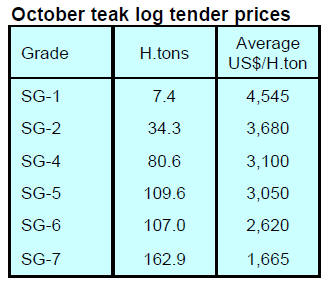
7. INDIA
Positive growth in the third quarter
India's economy is showing signs of recovering from the
impact, first, of the removal from circulation of the 500
rupee ($7.50) and 1,000 rupee ($15) notes which
accounted for over 80% of notes in circulation and
secondly the introduction of a standard Goods and
Services Tax (GST) replacing complicated state systems
with a single national rates. Analysts say that the latest
growth data may indicate that the negative impact of these
two changes is diminishing.
Main timber price indices trend down
India’s official wholesale price index for all commodities
(Base: 2011-12=100) for October 2017 released by the
Office of the Economic Adviser to the government (OEA)
rose to 115.5 from 114.3 for the previous month.
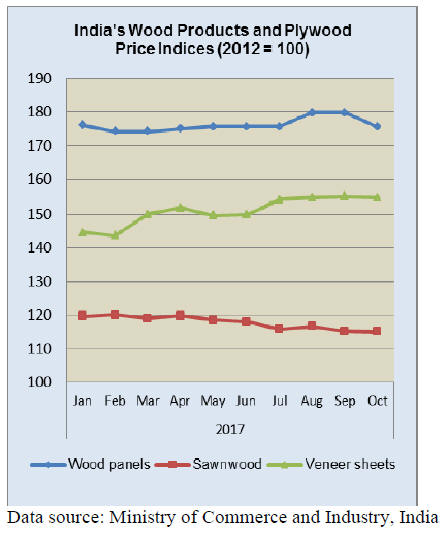
The annual rate of inflation, based on monthly WPI,
stood
at 3.59% (provisional) for October 2017 compared to
2.6% for the previous month.
Inflation for this financial year so far was 2.03% compared
to a buildup rate of 3.53% in the corresponding period of
the previous year.
The October wholesale price indices for wood panels,
sawnwood and veneers all declined in October.
The press release from the Ministry of Commerce and Industry
can be found at:
http://eaindustry.nic.in/cmonthly.pdf
European plywood gaining a foothold in India
Plywood manufactured in Europe is steadily gaining a
foothold in the Indian market according to the November
issue of Ply Reporter, the Indian panel sector journal.
Birch plywood has caught the attention of architects and
designers because of the high standard of the product.
Ply Reporter says a dealer in Delhi commented that
European plywood is as good as top quality India made
plywood because of its dimensional stability, clean look
and strength. As demand in India ramps up creating a
supply demand gap traders are looking for alternative
plywood suppliers.
No change in prices for plantation teak logs
The demand for imported teak logs remains steady and the
recent reduction of the GST on some wood products is
encouraging importers to believe there is hope that GST
rates for other wood products will be eventually achieved.
At the time of this report prices continue within the range
a previously stated.
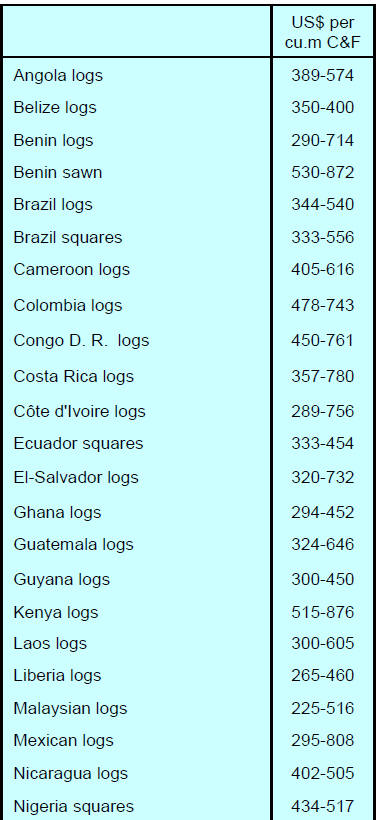
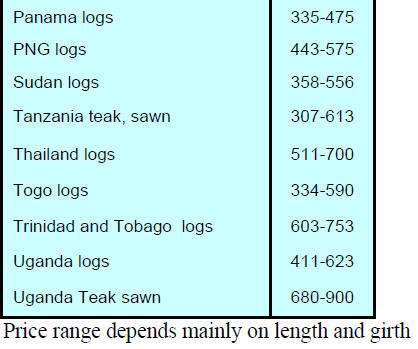
Locally sawn hardwood prices
Prices for imported hardwoods remain unchanged.
Domestic demand for imported sawnwood continues to be
firm and the there is growing substitution of hardwoods
for imported plantation teak as the quality and size of
plantation teak logs has deteriorated recently.

Myanmar teak prices
Importers have indicated that while the availability of
sawn teak from Myanmar is satisfactory ex-yard sales are
flat because of the high price of imported sawn teak
compared with some other good quality sawn hardwoods.
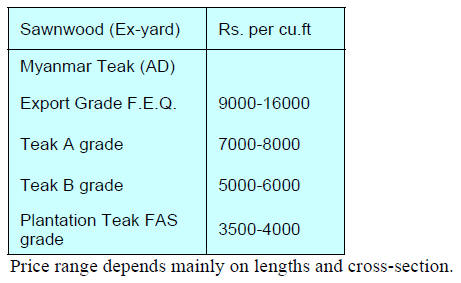
Prices for imported sawnwood
Prices for imported sawnwood (KD 12%) remain
unchanged.
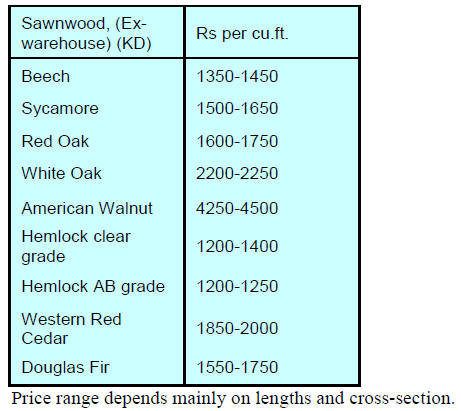
Prices for WBP and MR plywood manufactured
by
domestic mills
Plywood manufacturers in India are still celebrating the
reduction in GST on panels which helps them face the
challenge from imported plywood.

8. BRAZIL
Commitment to sustainable
forest management gets a
boost
Preference for timber from sustainably managed forests
and reforestation areas is now part of the government’s
procurement programme. The federal government has
included wood in the list of materials for which
sustainable practices are a prerequisite for procurement.
This development is seen as contributing to the
implementation of the Action Plan for Prevention and
Control of Deforestation in the Amazon (PPCDAm) and
Cerrado (PPCerrado) 2016-2020. These aim to reduce
deforestation but an added benefit is that this measure will
expand the market for wood products.
The measure also changed the thinking of the Interministerial
Commission on Sustainability in the Public
Administration (CISAP) linked to the Ministry of
Planning, Development and Management.
The Commission defines how the new standard will be
applied to public procurement and Decree Nº 9.178, of
October 24, 2017, confirms that sustainable criteria and
practices are acknowledged in the bidding documents as a
technical qualification.
The Brazilian Forest Service will define the technical
criteria for the implementation of the new rule and
promote the dissemination of this measure and conduct
training courses in procurement for public agencies.
Forest concessions system a tool to combat illegal
harvesting
One of the greatest challenges in the Amazon is to
reconcile job and income generation with forest
conservation. Forest concessions are one of the
instruments to achieve this goal.
According to a November report from Huffington Post
Brazil, the forest concession system of management can
contribute to combating predatory extraction in the
Amazon by delivering verified legal timber to the market
and efforts are underway to make the Documents of Forest
Origin (Documentos de Origem Florestal - DOF) system
more transparent .
The DOF is an instrument for oversight and control of
forest product transportation throughout the country from
the forest to its final destination. Greater transparency will
allow for effective social control and the creation of robust
public and private instruments to combat illegal activities
in the sector.
The Ministry of the Environment says that much of the
wood products from the Amazon are derived from illegal
activities and that a large part of this occurs in protected
areas such as conservation units (UCs) and indigenous
reserves.
There are 29 forest concession areas in Brazil and
almost 1
million cubic metres of wood have been sustainably
produced in these areas. The potential of the forest
concession approach in the fight against illegal harvesting
and the promotion of fair trade in Amazonian timber is yet
to be fully exploited.
Transparency in the issuance of DOFs will impart
legitimacy on forest products among traders and
consumers. The joint expansion of these two measures is
fundamental to ensure legitimate trade in timber from the
Amazon.
Export up-date
In October 2017, the value of Brazilian exports of woodbased
products (except pulp and paper) increased 44%
compared to October 2016, from US$ 86.8 million to US$
69.0 million.
Pine sawnwood exports increased in value by almost 50%
between October 2016 (US$28.5 million) and October
2017 (US$42.6 million) while the volume of exports rose
41% over the same period, from 146,700 cu.m to 207,100
cu.m.
In the sam 10 month period tropical sawnwood exports
increased 67% in volume, from 26,100 cu.m in October
2016 to 43,600 cu.m in October 2017 an the value of
exports rose 63%from US$12.1 million to US$19.7
million, compared to October 2016.
The positive trend continued with pine plywood where
exports jumped 50% in from US$34.5 million to US$51.8
million. Over the same 10 month period export volumes
increased 33% from 129,800 cu.m to 172,900 cu.m.
As for tropical plywood, Brazilian exports were 7.0%
higher in volume and value rising from 14,200 cu.m (US$
5.6 million) in October 2016 to 15,200 cu.m (US$ 6.0
million) in October 2017.
Finally, exports of wooden furniture from Brazil increased
from US$35.6 million in October 2016 to US$44.8 million
in October this year, 26% rise.
Wood-based panel export growth
According to the Brazilian Tree Industry Association
(IBÁ) in the first nine months of this year woodbased
panel exports were worth US$212 million, a 20% increase
year on year. On the other hand imports of woodbased
panels remained stable at around US$3 million.
Latin American countries remained the main markets for
Brazil’s woodbased panels in the first nine months of this
year with export revenues of over US$ 110 million, a 17%
increase compared to last year.
Asia and Oceania markets grew 70% over the same period
and the value of exports jumped from US$20 million in
the first nine months of 2016 to US$34 million over the
same period this year. In contrast, exports to Europe fell
by around 50% to US$3 million.
In the period from January to September 2017 the
domestic market absorbed 4.8 million cubic metres.
PNQM updated to meet CN Mark requirements
The National Programme for Wood Quality (PNQM)
developed by the Brazilian Association of Mechanically-
Processed Timber Industry (ABIMCI) recently included
new procedures such as preventive maintenance of
equipment, competency training, customer complaints
policy and supplier qualification. The objective is to
improve the programme and enable improvements in
control and traceability of production.
The PNQM provides a standardised structure for
manufacturing process control from the receipt of raw
material and inputs to final products packaging and
shipping.
Companies that implement PNQM's management system
have seen gains in productivity and competitiveness,
reduced losses and costs and guaranteed access to the main
consumer markets as their products meet national and
international technical standards.
The other advantages for companies that implement the
PNQM are improvements in internal culture and enhanced
product image that leads to greater customer satisfaction.
The process also stimulates continuous improvement and
control of the manufacturing process.
The updated PNQM meets the requirements of BM Trada,
a certification body in the UK with which ABIMCI has an
agreement to facilitate CE Marking certification for
structural panels from Brazil.
The CE system requires the manufacturer to meet the
requirements of EN (European Standard) through the
construction products regulation - CPR (305/2011),
governed by standard EN 13986 + A1 2015 for woodbased
panels, valid for 28 countries of the European
Economic Area and three of the four member states of the
EFTA.


9. PERU
President of Peru addresses
ITTC
Peru hosted the 53rd Session of the International Tropical
Timber Council (ITTC) in late November. The meeting
brought together ITTO member countries who account for
around 90% of the global trade in tropical timber.
Peru, together with other producer and consumer
countries, is part of the International Tropical Timber
Organization (ITTO), an intergovernmental institution that
promotes the conservation, management, utilisation and
sustainable trade of tropical forest resources among its
members.
The President of the Republic, Pedro Pablo Kuczynski,
attended the opening ceremony where he said conserving
and sustainably managing Peru’s vast forest resources is
fundamentally important for ensuring the country’s future.
“The position of Peru is clear,” said Mr Kuczynski. “It is
to promote, along with other countries, the conservation of
tropical forests, because they provide oxygen and
freshwater supply and mitigate climate change.
If we don’t protect our tropical forests, it will have a huge
impact on future generations.”
Mr Kuczynski also spoke about a new Peruvian initiative,
Sierra Azul, one of the aims of which is to restore
degraded lands in the Peruvian Andes by establishing tree
plantations to protect water catchments and generate jobs
in rural communities.
Peru is a founder member of ITTO and has benefitted
from projects worth nearly US$20 million addressing the
sustainable management and use of tropical timber.
High level dialogue on development of the forestry
sector
The Association of Exporters (ADEX) recently organised
a high level dialogue seeking to identify and promote
actions for an efficient and sustainable forest management
system that will lead to the development of the sector and
that involves the entire productive chain.
Representatives from the National Forestry and Wildlife
Service (Serfor), the Forestry and Wildlife Resources
Oversight Agency (Osinfor), the regional governments,
the Ministry of Production, the National Forestry
Confederation (CONAFOR), participated in this meeting
along with the National Forestry Chamber and ADEX
executives.
Peruvian exports of wood to August 2017
According to ADEX, as of August 2017, the FOB value of
exports of Peruvian wood products amounted to US$77.1
million down on the US$88.3 million recorded in the same
period in 2016.
China continues as the main export market for the wood
products sector (50%) while Mexico is in second place
with a 14% share. Exports to the US are around 10% of
total exports but export volumes have been falling.
Exports of sawnwood go mainly to the Dominican
Republic (31%) and China (26%) but exports to China
have been falling as they have to US and South Korea.
